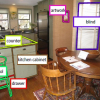131
click to vote
CVPR
2012
IEEE
13 years 2 months ago
2012
IEEE
Objects in scenes interact with each other in complex ways. A key observation is that these interactions manifest themselves as predictable visual patterns in the image. Discoveri...
131
click to vote
PAMI
2012
13 years 2 months ago
2012
—There has been a growing interest in exploiting contextual information in addition to local features to detect and localize multiple object categories in an image. A context mod...
110
click to vote
ICCV
2011
IEEE
14 years 12 days ago
2011
IEEE
Template-based object detectors such as the deformable parts model of Felzenszwalb et al. [11] achieve state-ofthe-art performance for a variety of object categories, but are stil...
88
Voted
JOCN
2010
14 years 7 months ago
2010
The human brain contains cortical areas specialized in representing object categories. Visual experience is known to change the responses in these category-selective areas of the ...
88
Voted
ICONIP
2004
15 years 1 months ago
2004
Previous research on children's categorizations has suggested that children use perceptual and conceptual knowledge to generalize object names. Especially, the relation betwee...
NIPS
2007
15 years 1 months ago
2007
Current object recognition systems can only recognize a limited number of object categories; scaling up to many categories is the next challenge. We seek to build a system to reco...
120
Voted
ICVGIP
2008
15 years 1 months ago
2008
Recognition of object categories from their images is extremely challenging due to the large intra-class variations, and variations in pose, illumination and scale, in addition to...
121
click to vote
DICTA
2008
15 years 1 months ago
2008
Many object categories are better characterized by the shape of their contour than by local appearance properties like texture or color. Multi-local features are designed in order...
123
click to vote
CVPR
2006
IEEE
15 years 6 months ago
2006
IEEE
We develop an integrated, probabilistic model for the appearance and three-dimensional geometry of cluttered scenes. Object categories are modeled via distributions over the 3D lo...
CVPR
2010
IEEE
15 years 8 months ago
2010
IEEE
Learning models for recognizing objects with few or no training examples is important, due to the intrinsic longtailed distribution of objects in the real world. In this paper, we...

